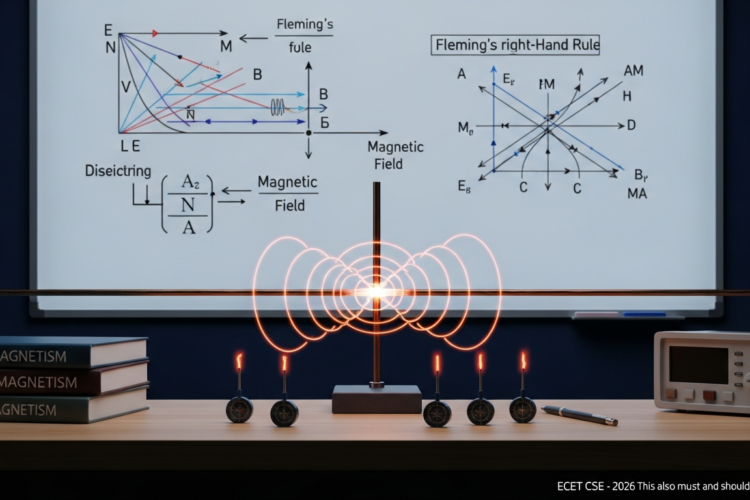
Arrays form the foundation of Data Structures in ECET 2026, especially under the C-23 curriculum for CSE diploma students. Whether it’s accessing elements, understanding how memory is organized, or traversing arrays—this topic carries both theoretical and logical weight in the exam. Let’s dive into arrays, memory layout, and allocation types—then master them with 10 expected MCQs, answers, and explanations.
📘 Concept Notes – Arrays & Memory Allocation
📦 What is an Array?
An array is a collection of elements of the same data type stored in contiguous memory locations. Arrays are used to store data efficiently and access it using index numbers.
🧾 Key Properties:
- Fixed-size (declared during initialization).
- Index starts at 0.
- Stored in continuous memory.
- Types: 1D, 2D, Multi-dimensional arrays.
🧠 Array Declaration & Initialization:
int marks[5]; // Declares an array of 5 integers
int marks[5] = {90, 85, 78, 88, 92}; // Declaration with initializationMemory Allocation in Arrays:
📌 Static Memory Allocation:
- Memory is allocated at compile-time.
- Example: arrays in C declared with fixed size.
- Cannot be resized later.
📌 Dynamic Memory Allocation:
- Memory is allocated at run-time using pointers.
- In C:
malloc(),calloc(),realloc(), andfree() - Offers flexibility in size but needs manual management.
🔍 Formula to Access Address in Array (for 1D):
Address(A[i]) = BaseAddress + i * SizeOfDatatypeThis helps calculate element position in memory.
📌 Why Arrays Matter in ECET?
- Appear in both Data Structures & C Programming sections.
- Easy to predict, solve, and score.
- Vital for solving advanced concepts like searching, sorting, and matrix operations.
🔟 10 Most Expected MCQs – ECET 2026 [Arrays & Memory Allocation]
Q1. What is the index of the first element in an array?
A) 1
B) -1
C) 0
D) Depends on language
Q2. Arrays store elements in:
A) Random locations
B) Non-contiguous memory
C) Contiguous memory
D) Filesystem
Q3. Which of the following is correct array declaration in C?
A) int arr();
B) arr[10];
C) int arr[10];
D) int[10] arr;
Q4. Static memory allocation happens at:
A) Run time
B) Load time
C) Compile time
D) Execution time
Q5. Which function is used for dynamic memory allocation in C?
A) alloc()
B) malloc()
C) new()
D) pointer()
Q6. What is the output of arr[2] in int arr[4] = {10, 20, 30, 40};?
A) 10
B) 20
C) 30
D) 40
Q7. Which memory allocation method allows resizing?
A) malloc()
B) realloc()
C) calloc()
D) static allocation
Q8. What is the base address in array memory calculation?
A) Last element’s address
B) Any random address
C) Address of index 1
D) Address of first element
Q9. Dynamic memory allocation returns:
A) Float
B) Pointer
C) Integer
D) String
Q10. Which of the following allocates memory and initializes it to zero?
A) malloc()
B) realloc()
C) free()
D) calloc()
✅ Answer Key Table
| Q.No | Answer |
|---|---|
| Q1 | C |
| Q2 | C |
| Q3 | C |
| Q4 | C |
| Q5 | B |
| Q6 | C |
| Q7 | B |
| Q8 | D |
| Q9 | B |
| Q10 | D |
🧠 Explanations of All Answers
- Q1 → C: Array indexing always starts from 0.
- Q2 → C: Arrays are stored in contiguous memory.
- Q3 → C: Proper C syntax for declaring arrays.
- Q4 → C: Static memory allocation happens at compile-time.
- Q5 → B:
malloc()dynamically allocates memory at runtime. - Q6 → C: Index 2 = 3rd element = 30.
- Q7 → B:
realloc()can change previously allocated size. - Q8 → D: Base address is the address of the first element.
- Q9 → B: Dynamic functions return pointers.
- Q10 → D:
calloc()allocates and initializes memory to 0.
🎯 Why This Practice Matters for ECET 2026
Arrays & memory allocation are among the most common MCQ topics in CSE ECET. These questions are direct, predictable, and score-friendly. Practicing these helps in both C Programming and Data Structures sections, giving you an edge over others. Clarity here builds the base for advanced topics like linked lists and dynamic structures.
📲 Join Our ECET Prep Community on Telegram
Get exclusive MCQs, video explainers, and PDFs for all Day-wise ECET sessions.
👉 Join us now: @LearnNewThingsHub



